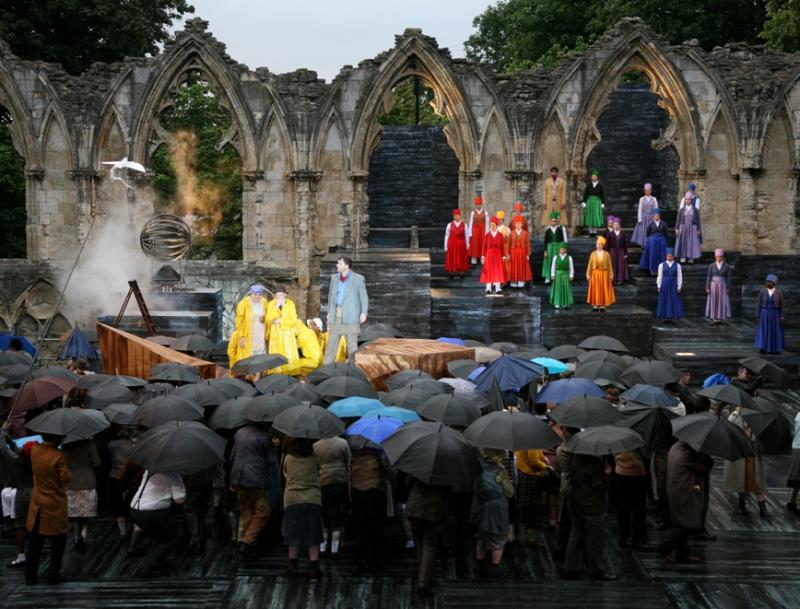Continuing until 27th August
at York Museum Gardens
VIDEO: The York Mystery Plays — cinematic trailer
Is it the greatest story ever told, or the most indulgent nativity ever staged? The return of the York Mystery Plays — this summer’s blue-ribbon theatrical spectacular in the North — beguiles upon entry but bemuses by exit.
In between is a sacred tale about the eternal battle of good and evil, from Creation to the Last Judgement. The show’s subject matter is as epic as its telling, which involves more than 1700 volunteers (including 500 cast members) and takes place in the ruins of St Mary’s Abbey. It’s the UK’s largest outdoor theatre production this year.
The timing of this showpiece alone is enough to make its mark on a 700-year-old heritage in York. As birds flutter over a pink, cloudless sunset, a sense of history is not lost on a crisp-crunching, wine-guzzling audience, who take their seats, prepared with blankets for the evening.
The Plays were once paraded through the streets of the medieval city, the earliest known performance dating back to 1376. For hundreds of years, they were a method by which Christian messages were transmitted to the public, continuing until the early Reformation. Since the revival of the tradition in 1951, there have been regular stagings of the Plays, the most previous falling during the Millennium celebrations.
Directed by Paul Burbridge and Damian Cruden, this latest addition to the cycle — performed at York Museum Gardens for the first time since 1988 — has been adapted by Mike Kenny, the man who put his hands to 2011’s Olivier Award-winning The Railway Children. Ferdinand Kingsley, son of Sir Ben, plays God and Jesus, opposite Graeme Hawley — former Coronation Street villain John Snape — as the Devil.

The bespoke, 1400-capacity auditorium houses a multi-layered set of smoke-billowing trapdoors and spotlit platforms. Kingsley takes to the stage a few minutes early, with the final few arrivals still finding their seats in the crowd, and his eagerness doesn’t let up — growing, in fact, into a fiery-eyed, hyperbolised portrayal of the Creator. Hawley encounters no obstacles as Satan. Though, despite his experience playing bad guys in soapland, his performance here never quite manages to draw blood.
Some minor pyrotechnics, a 97-strong choir and an array of giant balloons guide us through the opening scenes — including the Garden of Eden, which features dozens of merry hedge-trimmers along on bicycles. Christopher Madin’s cinematic score is perfect acoustic foil for the melodrama on stage, and, at times, the choreography and general direction is bedazzling.
The costumes are undeniably impressive, too. Mary wears a headscarf and Joseph a flat cap as the biblical narrative sets itself in post-war Yorkshire. Lines like, ‘Nae Noah, I am not best-pleased,” provoke echoes of elderly laughter.
Yes, visually, it is stunning, majestic, superb. But there comes a time when, perhaps as the midges begin biting your skin, you realise that any sort of intellectual stimulation just isn’t going to happen — because this is a summary of the Old and New Testaments, and not much more. That these Plays — going right through when Jesus made the blind man see, the last supper, the crucifixion, and… well, you know what happens next — are a bit much at over three hours long.
There’s also something formulaic about the way in which the large swathes of cast are assembling and then dispersing en masse at the end of each scene, and a lack of chemistry between some of the performers — whose hundreds of names run four pages in the programme.
And yet, in the end, the colossal effort that went into this production — the 2500 people involved, the hours of rehearsal time, the 1400 metres of cabling required — is mostly let down by the greatest story ever told itself. The dialogue offers little to engage a modern, secular audience, and, even accounting for the Yorkshire-tinged embellishments in Kenny’s script, fails to build on your prior impressions of the Bible.
For all the seductive grandeur of this project (more shows to be staged here, please) it feels like an opportunity missed.